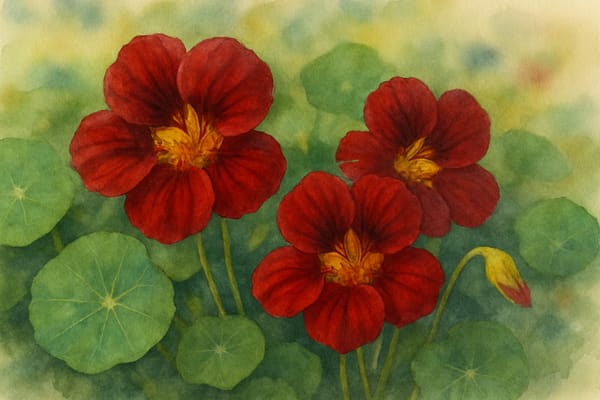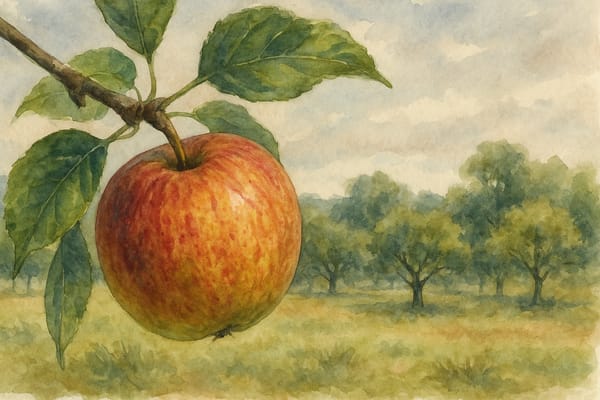Velvet Blooms and Peppery Leaves for the Romantic Garden Table
There’s something irresistibly nostalgic about nasturtiums. Their tumbling leaves, flamboyant flowers, and unruly charm recall the kind of garden that doesn’t mind a little mischief. And ‘Empress of India’, with her rich crimson petals and sultry blue-green foliage, may be the most captivating of them all.
This old-fashioned variety has found her way into Cornish cottage gardens for generations—flourishing in sea-winds, scrambling along sun-baked stone walls, and peering cheerfully from zinc tubs outside kitchen doors. Easy to grow from seed, unfussy about soil, and generous in both bloom and flavour, she’s a summer companion worth inviting in.
A Flower for the Free-Spirited Plot
Start with the seed. Big and knobbly, nasturtium seeds feel substantial in the hand—almost like miniature treasure stones. They’re pleasing to sow and simple enough for a child’s first garden experiment, yet still sophisticated in the right setting.
‘Empress of India’ can be sown directly where she is to grow from March through May, once the worst of the frost has passed and the soil begins to warm. If your spring feels slow to arrive, you can start her off indoors two to three weeks earlier in small pots or modules on a bright windowsill. She doesn’t need mollycoddling—just light, warmth, and a bit of patience.
Tip: Soak seeds in lukewarm water overnight before sowing. It helps soften the tough outer coat and coaxes them into quicker, more even germination.
How to Plant
Outdoors, prepare your patch by clearing weeds and raking the soil to a fine tilth. Nasturtiums like poor soil—that’s part of their magic. Rich, nitrogen-heavy ground will only give you leaves at the expense of blooms.
Water the area gently before sowing, then drop the seeds into shallow drills or individual holes about 1.5 to 2cm deep, spaced 10–12cm apart. Cover them lightly and pat the soil firm.
Once the seedlings appear (usually within 7–14 days), thin them out to 20–30cm apart to give them breathing space.
Indoors, use a free-draining seed compost and sow one seed per pot or cell at roughly 2cm depth. Keep them warm (18–24°C), and move them gradually outdoors once the frosts are behind you.
Where She’ll Be Happiest
Nasturtiums thrive in full sun, where their flowers deepen in colour and foliage remains tight and tidy. While they’ll tolerate a bit of shade, you’ll see fewer blooms and leggier growth.
Soil should be poor to moderately fertile and well-drained. Think of the scrappy margins of a dry wall, or the dustier edge of a path. Container gardens suit them beautifully—but choose a free-draining compost and water them with restraint.
Water, Feed, and Forget
Water your young plants regularly as they get established, but once they’ve settled in, nasturtiums prefer to fend for themselves. Overwatering leads to floppy growth and fewer flowers.
Feeding is rarely necessary. In fact, the less you pamper them, the better they perform. In very poor soil, a diluted organic liquid feed every 4–6 weeks is enough—but in most cases, they’ll thank you for being left alone.
Care and Companionship
To keep the display going strong from early summer through to the first frost, it helps to pinch out the growing tips when plants are young—this encourages bushiness and more flower spikes.
Deadheading is the secret to abundance. Remove spent blooms regularly and your nasturtium will pour out more in gratitude.
Keep an eye out for aphids and cabbage white caterpillars, which love nasturtiums almost as much as we do. But don’t be too hasty with sprays. Nasturtiums serve as useful trap crops, drawing pests away from your brassicas and lettuces. A blast of water or visit from a ladybird may be all the intervention required.
The Edible Wild
What makes ‘Empress of India’ especially delightful is that every part of her is edible. The young leaves bring a peppery brightness to salads, while the deep red flowers float beautifully atop summer puddings or herb butter. Even the plump green seed pods can be harvested and pickled as “poor man’s capers.”
Just be sure to leave a few to ripen and fall. Nasturtiums self-seed freely, and you may well find her popping up again next spring, in unexpected corners of the garden.
A Plant with Heart
For all her vibrance and vintage glamour, Nasturtium ‘Empress of India’ is a plant of humility. She doesn’t need rich soil or constant care. She thrives in overlooked spaces and gives far more than she takes. Her roots run shallow, but her presence is generous—feeding bees, soothing dinners, and delighting gardeners from plot to plate.
Plant her in pots beside your bench, weave her through a herb border, or let her spill from a window box with lazy grace. However you welcome her in, she’ll bring life, colour, and a hint of wildness to your Cornish garden.











